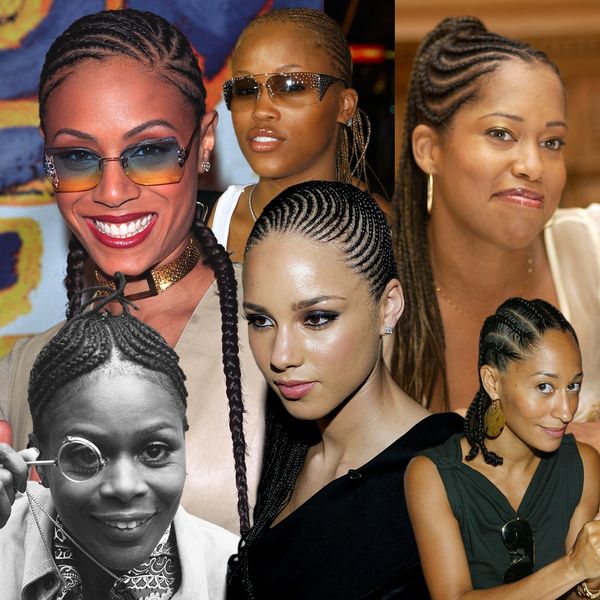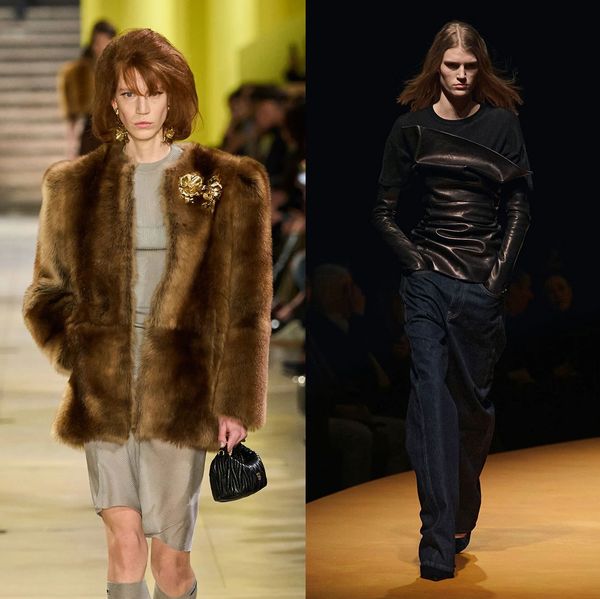Before Jess Bush Was an Actress, She Was an Artist
The 'Star Trek' phenom on art, self-expression, and identity.
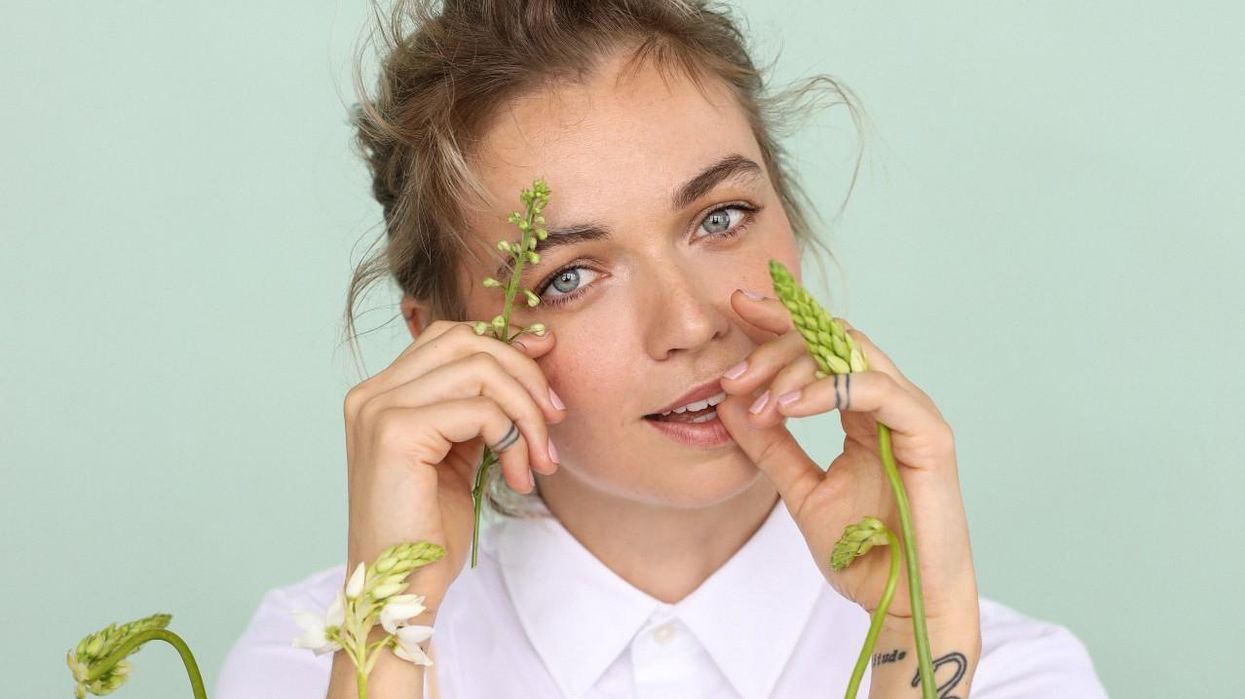
“It’s never really been a conscious decision,” Jess Bush says of her inherent desire to express herself through art. “It's a compulsion to make; it's just how my body and my mind works.” Though you may know the Australia native as Christine Chapel in Star Trek: Strange New Worlds, Bush was a visual artist first. She stumbled into acting much later.
At eight years old, the self-taught creative recounts telling those around her she wanted to be an artist when she grew up. Today, her approach denotes nothing of the childlike fantasy of painterly palettes, easels, and French mustaches. In her most recognized "Bee Totem" sculpture project, Bush preserves bees post mortem in spheres of crystal resin. “I think witnessing something in its death makes you feel its whole life in one moment,” she explains. When you stack hundreds of these eerily fascinating graves in a grid-like structure, the result is a haunting take on the relationship between living things and this earth.
Though "Bee Totem" has largely served as her magnum opus—she’s even expanded the insects into jewelry—Bush also dabbles in other mediums. Currently, she’s experimenting with photography. As is the artist's way, she assures me inspiration can strike at any time. So she captures anything. "Moments in life, people, interactions, beautiful scenery. It's literally been like a photo journal. I didn't anticipate it to be another string of my art career, but it's moving in that direction and I'm curious to see where it goes,” Bush says. She’s drawn to this method of photographic documentation for its honesty.
It’s this hunt for the truth that connects the two seemingly unlike poles in Bush’s life: visual art and acting. “When you're acting, you're always pursuing a deeper and clearer vision of truth,” she muses. “I love to dedicate my time and energy to [it], and to inspire people to be more truthful with themselves, with each other, to understand themselves better, to feel seen.” Despite this ephemeral connection, the two schools of thought remain largely separate—she can only dedicate her creativity to one at a time. Though the lasting mental fallout of one always seems to leak into the other.
Ahead, Bush discusses more about self-expression, personal style, and the key differences between visual art and acting.
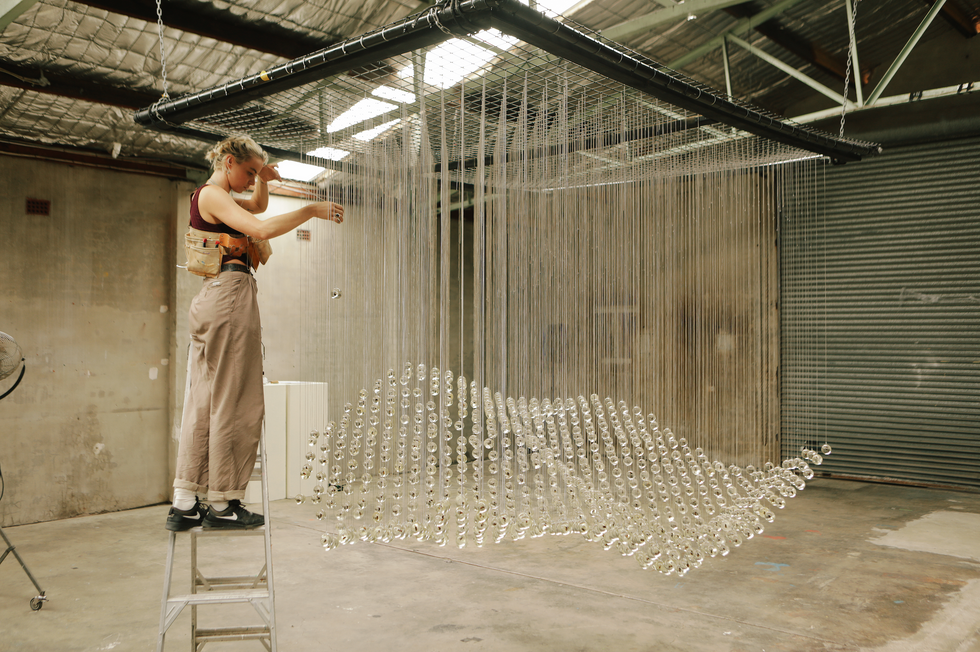
Bush works on her sculpture project, "Bee Totem."
Photo: Courtesy of Jess Bush
In all of your different forms of artistic expression, what came first? You were more into visual art before you got into acting, correct?
“Yes, I have been making art forever. I don't really remember a time when it wasn't my mode of understanding the world. I just remember being eight, when people ask you what you want to be when you grow up, and everyone was like, ‘I want to be an astronaut, I want to be a firefighter.’ I always said that I wanted to be an artist, but I didn't really know that I could express myself clearly in that way until I was about 15, and then from there [I] have just always made art. I started selling [it] when I was about 19 and never looked back.”
You say you've only taken one art class. How do you move from taking a single class to making these orbs of dead bees?
“It's an interesting question because it's so hard to know. I painted for years and years and years, and I think that I just naturally wanted a different tool to excavate. I wanted to explore a little deeper and get a new perspective. When I moved from painting into sculpture, I would've been 23, 24 [years old]. I booked an acting gig that gave me a chunk of money and allowed me to actually sit back and think, if I'm not producing for anyone, if I just have time to experiment and make mistakes, what would I actually want to do? And honestly, it was also just a broadening of my perspective through experimenting with psychedelics and stuff like that, that widened my scope and my hunger for experimentation. But it took years to arrive at what I'm making now.”
What is it about art that sparks something inside of you? Is it the process, the final result, the messaging? What lights you up?
“It's never really been a conscious decision, honestly. It's a compulsion to make. It's how my body and my mind works, and I think it's the best way that I can share. It’s always been who I am. And personally, I think that art is one of the most important things in life and in society. I feel immensely privileged that I have the opportunity to contribute to that.”
What are the materials or tools that you're gravitating toward right now?
“Interestingly enough, I have been really drawn to photography recently. While I have been shooting in Toronto, I haven't necessarily had this physical space to work on my "Bee Totem," which is my ongoing sculptural project, because it requires so much space and so many tools and so much time. So that energy has been looking for somewhere else to come out. And also, I think the craft of acting has pulled me more towards a photographic point of view—wanting to get closer to moments of vulnerability and truth in others and in life, and capturing that.”
Why did you choose to preserve something dead in art? It has such a startlingly eerie quality.
“I have always had a fascination [with death]. I love bones, I love finding dead things, I love taxidermy. I've never had to put this into words actually. I think witnessing something in its death makes you feel its whole life in one moment, and there's something so poignant about seeing something in its last resting position. I just find it really beautiful, and there's a certain depth to capturing that.”
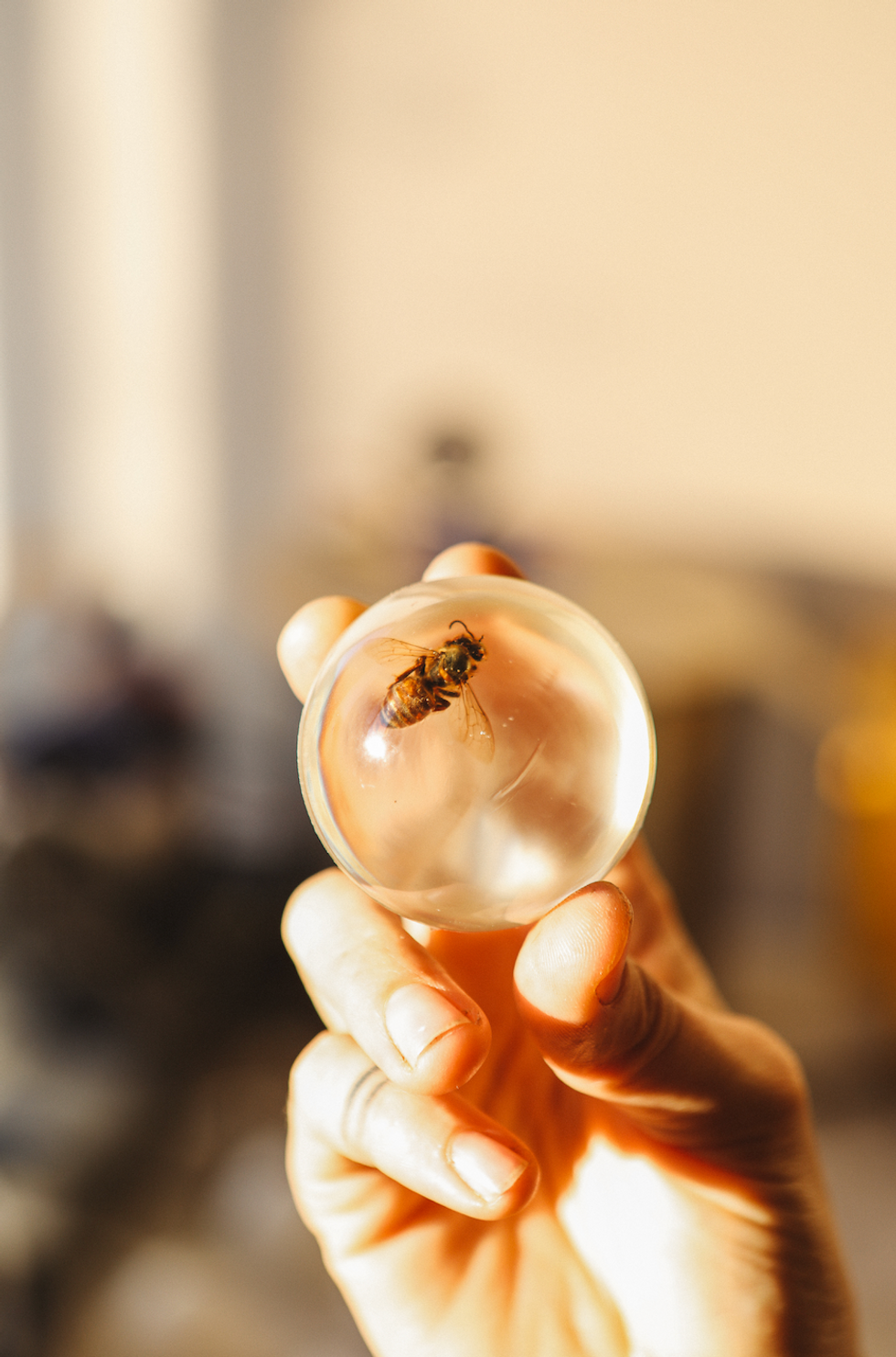
Hundreds of these spheres of crystal resin encasing dead bees make up Bush's "Bee Totem" project.
Photo: Courtesy of Jess Bush
When did acting come into the picture?
“Late. I always wanted to try acting, but there was something holding me back from it. I think partly there was a fear of exposure. I also told myself that I should focus on my art, but there was always an inkling that [acting] was something that would be for me. I think I was 21 [years old] or so, and dating an actor and there were other actors around me, so I listened to that and tried it out when I was 21, and of course loved it. I haven't looked back since then.”
What does acting spark in you?
“It's infinitely challenging; you can never master it. Visual art and acting are so different in a way that really captured my attention. When you make visual art, it's about the end product, whereas with acting, you can't be thinking about the end product at all. It's all about being seen in process: always in process, always in a state of becoming, always in motion. So that to me was a really exciting and terrifying creative challenge. When you're acting, you're always pursuing a deeper and clearer vision of truth. That is something that I really love to dedicate my time and energy to—to inspire people to be more truthful with themselves, with each other, to understand themselves better, to feel seen. It's something that I'm really proud to use my life for.”
What does your process look like? In the case of Star Trek, you get your role, then what?
"For Nurse Chapel, I did a lot of research into Star Trek more broadly, and understanding its context through the 55 years that it's existed. It has been really important to know where I fit in. I also read and continue to read nursing memoirs and watched documentaries about medevac and different medical practitioners, and that's been really helpful. There's always more to find. And then my acting coaches and I work together to build a character with their methods that are physically based. And then onwards into the project, the development continues throughout. It's always a process of listening and adjusting and growing.”
Is there any overlap in process when you are building a character and developing an exhibit?
“For me they're completely different and I find it really hard to engage with both at the same time. I've tried to, and I can't. If I'm acting I can't make art, and vice versa. It just uses my system in a totally different way.”

Bush collects dead bees from beekeepers to preserve in the crystal resin.
Photo: Courtesy of Jess Bush
I'd love to hear about your experience with the more visual elements when you're in the acting world. When you get into costumes and on set, how does that start your brain rolling, especially in the realm of character development?
“Star Trek in particular is incredible for that. It's such a joy and a privilege to go to work with literally 400 artists who are all top of their game and really well-resourced. It's incredible. The sets are phenomenal, everything works. There are robotic beds and buttons. With this job in particular, there are certain instances where there's a lot of imagination required—you're working on a green screen with a tennis ball on a stick and you have to have a very precise and clear imagination, which I think the visual art side of me helps with—to be enveloped in ideas and images. But a lot of the time you have everything there, and so it's really easy to just let go and be in it.”
Your art is self-expression that's separate from your physical being, but you're also doing all this character play all the time. How have you figured out your own sense of style and creative expression—even little things, like how you want to dress, how you want to cut your hair, what tattoos you want to have?
“Wow, that's a good question. I'm definitely influenced by my environment. Even if it's imperceptible to other people, I can feel the way that I dress and present change with the city that I'm in [as I’m] influenced by the things around me. I don't know if this sounds dark, but I realized that some of the choices that I made when I was younger to cut my hair short and dress in certain ways was to honestly avoid unwanted attention from men. It is really sad to realize that I let myself be defined by that, but it's a matter of safety. Those things unfortunately influence me a little bit, even though I don't always want to admit it. I guess the rest is just being curious and playful with who I am, who I want to connect with, the energy that I want to attract, and just trying to listen to my bodily instinct rather than my intellectual mind about who I want to be.”
It seems like physicality plays a big role in your life—being a little more connected to your physical self than just your mind.
“Big time. A lot of the problems that we have and anxieties that we have are based on your intellectual understanding of the world, but if you connect to your body, you become present. You become aware of joy and love everywhere. For me, it's a safer way to exist.”
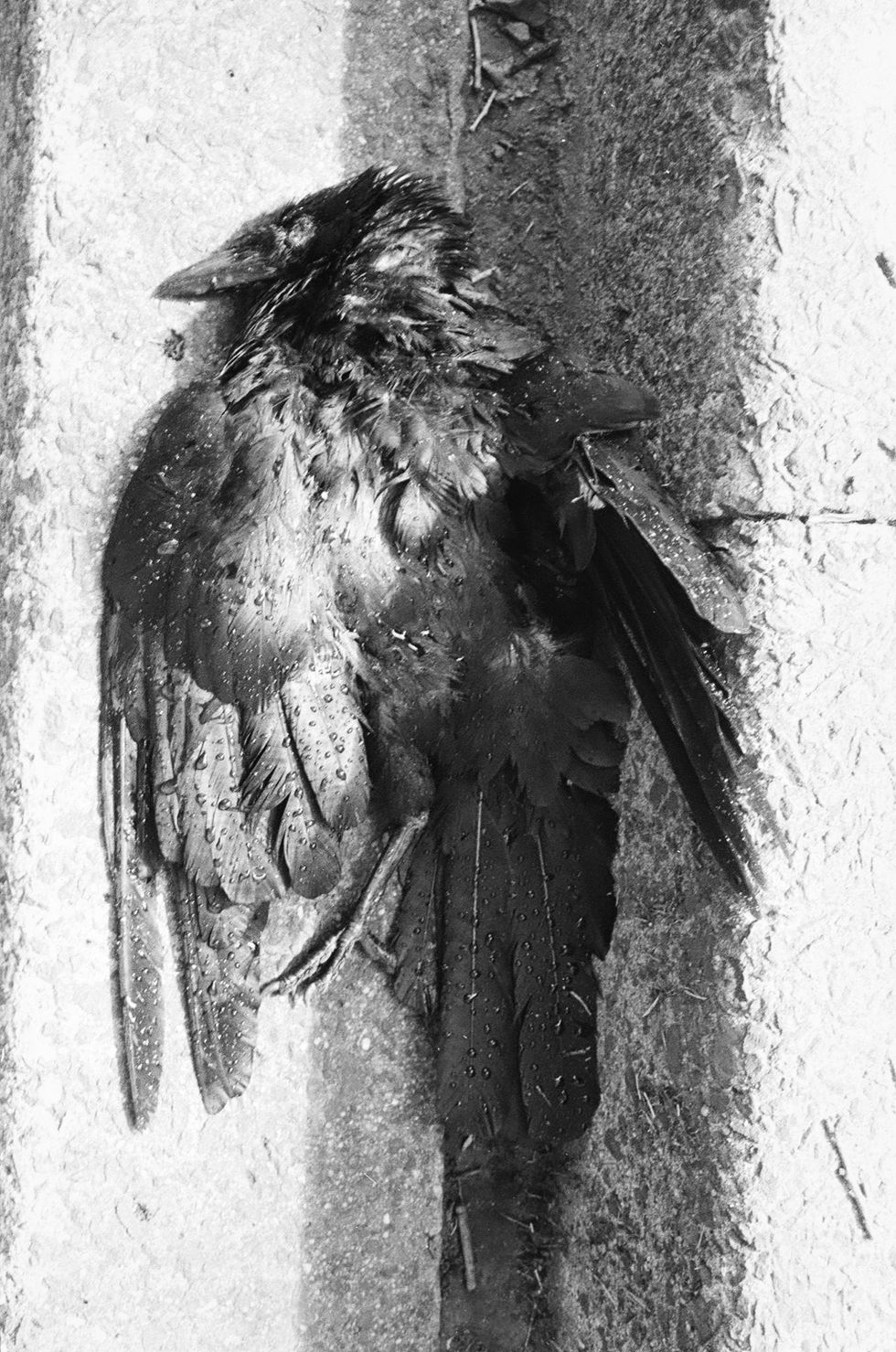
Bush experiments with photography as a more truthful form of art.
Photo: Jess Bush
What's next for you?
“I'm really excited for this decade of my life. I feel really supercharged creatively and more sure of what I'm making than I ever have. I just read this book about Ai Weiwei. He made this point, it was like, there's so much freedom in uncertainty and not defining yourself in any way. I was like, ‘Yes, Ai Weiwei, yes.’ I mean, that's hard. The world wants you to define yourself constantly, but [I’m trying to] be ready and open and present to inspire and support wonder and truthfulness in myself and in others and in whatever I make.”
That's what's so exciting about art in both visual art and film and TV. It's so project-based and temporary, which could be very scary for a lot of people, but then you're onto something else and you get to see how that fits into your life.
“Totally. And I felt the scary version of it. I felt the version of it that's very difficult to make ends meet with for a long time, so the place that I'm in now, I feel so grateful to be in and I'm enjoying it a lot.”
You've talked so much about slowing down. What is your favorite thing to do when you're having a slow day?
“People watching. Just sitting somewhere and watching people. New York is brilliant for people watching.”

